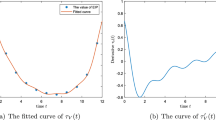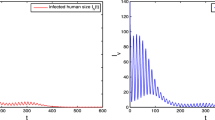Abstract
To explore the influence of spatial heterogeneity on mosquito-borne diseases, we formulate a reaction–diffusion model with general incidence rates. The basic reproduction ratio \(\mathcal {R}_0\) for this model is introduced and the threshold dynamics in terms of \(\mathcal {R}_0\) are obtained. In the case where the model is spatially homogeneous, the global asymptotic stability of the endemic equilibrium is proved when \(\mathcal {R}_0>1\). Under appropriate conditions, we establish the asymptotic profiles of \(\mathcal {R}_0\) in the case of small or large diffusion rates, and investigate the monotonicity of \(\mathcal {R}_0\) with respect to the heterogeneous diffusion coefficients. Numerically, the proposed model is applied to study the dengue fever transmission. Via performing simulations on the impacts of certain factors on \(\mathcal {R}_0\) and disease dynamics, we find some novel and interesting phenomena which can provide valuable information for the targeted implementation of disease control measures.














Similar content being viewed by others
Data availability
Data sharing was not applicable to this article as no datasets were generated or analyzed during the current study.
References
Allen LJS, Bolker BM, Lou Y, Nevai AL (2008) Asymptotic profiles of the steady states for an SIS epidemic reaction–diffusion model. Discrete Contin Dyn Syst 21:1–20
Andraud M, Hens N, Beutels P (2013) A simple periodic-forced model for dengue fitted to incidence data in Singapore. Math Biosci 244:22–28
Bhatt S, Gething PW, Brady OJ et al (2013) The global distribution and burden of dengue. Nature 496:504–507
Bacaër N, Guernaoui S (2006) The epidemic threshold of vector-borne diseases with seasonality. J Math Biol 53:421–436
Cai YL, Ding ZQ, Yang B et al (2019) Transmission dynamics of Zika virus with spatial structure—a case study in Rio de Janeiro, Brazil. Physica A 514:729–740
Cantrell RS, Cosner C (2003) Spatial ecology via reaction–diffusion equations. Wiley series in mathematical and computational biology. Wiley
Capasso V, Serio G (1978) A generalization of the Kermack–McKendrick deterministic epidemic model. Math Biosci 42:43–61
Chen S, Shi J (2021) Asymptotic profiles of basic reproduction number for epidemic spreading in heterogeneous environment. SIAM J Appl Math 80:1247–1271
Cui R-H, Lam K-Y, Lou Y (2017) Dynamics and asymptotic profiles of steady states of an epidemic model in advective environments. J Differ Equ 263:2343–2373
De Araujo AL, Boldrini JL, Calsavara BM (2016) An analysis of a mathematical model describing the geographic spread of dengue disease. J Math Anal Appl 444(1):298–325
Diekmann O, Heesterbeek JAP, Metz JAJ (1990) On the definition and the computation of the basic reproduction ratio \(R_0\) in the models for infectious disease in heterogeneous populations. J Math Biol 28:365–382
Dung L (1997) Dissipativity and global attractors for a class of quasilinear parabolic systems. Commun Partial Differ Equ 22:413–433
Dung L (1998) Global attractors and steady state solutions for a class of reaction–diffusion systems. J Differ Equ 147:1–29
Evans LC (1986) Partial differential equation. American Mathematical Society
Fang J, Lai X, Wang F-B (2020) Spatial dynamics of a dengue transmission model in time-space periodic environment. J Differ Equ 269:149–175
Gao D (2020) How does dispersal affect the infection size? SIAM J Appl Math 80:2144–2169
Hale JK (1969) Dynamical systems and stability. J Math Anal Appl 26:39–59
Hale JK (1988) Asymptotic behavior of dissipative systems. American Mathematical Society, Providence
Heesterbeek JAP, Metz JAJ (1993) The saturating contact rate in marriage and epidemic models. J Math Biol 31:529–539
Henry D (1981) Geometric theory of semilinear parabolic equations. Lecture notes in mathematics, vol 840. Springer, New York
Hess P (1991) Periodic–parabolic boundary value problems and positivity, Pitman research notes in mathematics series, vol 247. Longman Scientific & Technical, Harlow, copublished in the United States with Wiley, New York
Inaba H (2012) On a new perspective of the basic reproduction number in heterogeneous environments. J Math Biol 65:309–348
Krein MG, Rutman MA (1962) Linear operators leaving invariant a cone in a Banach space. Am Math Soc Transl 10:3–95
Lam K-Y, Lou Y (2016) Asymptotic behavior of the principal eigenvalue for cooperative elliptic systems and applications. J Dyn Differ Equ 28:29–48
Li F, Zhao X-Q (2021) Global dynamics of a reaction–diffusion model of Zika virus transmission with seasonality. Bull Math Biol 83:1–25
Li F, Liu J, Zhao X-Q (2019) A West Nile virus model with vertical transmission and periodic time delays. J Nonlinear Sci 30:449–486
Liang X, Zhang L, Zhao X-Q (2017) Basic reproduction ratios for periodic abstract functional differential equations (with application to a spatial model for Lyme disease). J Dyn Differ Equ 31:1247–1278
Magal P, Zhao X-Q (2005) Global attractors and steady states for uniformly persistent dynamical systems. SIAM J Math Anal 37:251–275
Magal P, Webb GF, Wu Y-X (2018) On a vector-host epidemic model with spatial structure. Nonlinearity 31:5589–5614
Magal P, Webb GF, Wu Y-X (2019) On the basic reproduction number of reaction–diffusion epidemic models. SIAM J Appl Math 79:284–304
Marino S, Hogue IB, Ray CJ, Kirschner DE (2008) A methodology for performing global uncertainty and sensitivity analysis in systems biology. J Theor Biol 46:178–196
Mitidieri E, Sweers G (1995) Weakly coupled elliptic systems and positivity. Math Nachr 173:259–286
Pakhare A, Sabde Y, Joshi A et al (2016) A study of spatial and meteorological determinants of dengue outbreak in Bhopal City in 2014. J Vector Borne Dis 53:225–233
Ruan S (2007) Spatial–temporal dynamics in nonlocal epidemiological models. In: Mathematics for life science and medicine. Springer, Berlin, pp 97–122
Shu H, Ma Z, Wang X-S, Wang L (2020) Viral diffusion and cell-to-cell transmission: mathematical analysis and simulation study. J Math Pures Appl 137:290–313
Shu H, Ma Z, Wang X-S (2021) Threshold dynamics of a nonlocal and delayed cholera model in a spatially heterogeneous environment. J Math Biol 83:41
Song P-F, Lou Y, **ao Y-N (2019) A spatial SEIRS reaction–diffusion model in heterogeneous environment. J Differ Equ 267:5084–5114
Sweers G (1992) Strong positivity in \(C({\bar{\Omega }})\) for elliptic systems. Math Z 209:251–271
Thieme HR (2009) Spectral bound and reproduction number for infinite-dimensional population structure and time heterogeneity. SIAM J Appl Math 70:188–211
Vaidya NK, Li X, Wang F-B (2019) Impact of spatially heterogeneous temperature on the dynamics of dengue epidemics. Discrete Contin Dyn Syst Ser B 24:321–349
Van den Driessche P, Watmough J (2002) Reproduction numbers and sub-threshold endemic equilibria for compartmental models of disease transmission. Math Biosci 180:29–48
Wang W, Zhao X-Q (2011) A nonlocal and time-delayed reaction–diffusion model of dengue transmission. SIAM J Appl Math 71:147–168
Wang W, Zhao X-Q (2012) Basic reproduction numbers for reaction–diffusion epidemic models. SIAM J Appl Dyn Syst 11:1652–1673
Wang L, Zhao H (2021) Modeling and dynamics analysis of Zika transmission with contaminated aquatic environments. Nonlinear Dyn 104:845–862
Wang X, Wang H, Li M (2019) \(R_0\) and sensitivity analysis of a predator–prey model with seasonality and maturation delay. Math Biosci 315:108225
Wang K, Zhao H, Wang H, Zhang R (2021) Traveling wave of a reaction–diffusion vector-borne disease model with nonlocal effects and distributed delay. J Dyn Differ Equ. https://doi.org/10.1007/s10884-021-10062-w
Wang X, Wang H, Li M (2021) Modeling rabies transmission in spatially heterogeneous environments via \(\theta \)-diffusion. Bull Math Biol 83:1–38
Wang H, Wang K, Kim Y-J (2022) Spatial segregation in reaction–diffusion epidemic models. SIAM J Appl Math 82(5):1680–1709. https://doi.org/10.1137/22M1485814
Webb GF (1985) Theory of nonlinear age-dependent population dynamics. CRC Press, Boca Raton
Wu R, Zhao X-Q (2019) A reaction–diffusion model of vector-borne disease with periodic delays. J Nonlinear Sci 29:29–64
Wu Y, Zou X (2018) Dynamics and profiles of a diffusive host–pathogen system with distinct dispersal rates. J Differ Equ 264:4989–5024
Yang HM, Macoris MLG, Galvani KC, Andrighetti MTM, Wanderley DMV (2009) Assessing the effects of temperature on the population of Aedes aegypti, the vector of dengue. Epidemiol Infect 137:1188–1202
Zhang L, Wang SM (2020) A time-periodic and reaction–diffusion Dengue fever model with extrinsic incubation period and crowding effects. Nonlinear Anal RWA 51:102988
Zhang R, Wang J (2022) On the global attractivity for a reaction–diffusion malaria model with incubation period in the vector population. J Math Biol 84:53
Zhang L, Zhao X-Q (2021) Asymptotic behavior of the basic reproduction ratio for periodic reaction–diffusion systems. SIAM J Math Anal 53:6873–6909
Zhang L, Wang Z, Zhao X-Q (2015) Threshold dynamics of a time periodic reaction–diffusion epidemic model with latent period. J Differ Equ 258:3011–3036
Zhao X-Q (2017) Dynamical systems in population biology, 2nd edn. Springer, New York
Zhao H, Wang L, Oliva SM, Zhu H (2020) Modeling and dynamics analysis of Zika transmission with limited medical resources. Bull Math Biol 82:1–50
Zhou P, **ao DM (2018) Global dynamics of a classical Lotka–Volterra competition–diffusion–advection system. J Funct Anal 275:356–380
Zhu M, Lin ZG, Zhang L (2020) Spatial–temporal risk index and transmission of a nonlocal dengue model. Nonlinear Anal RWA 53:103076
Acknowledgements
The authors are grateful to the editor and the anonymous reviewers for their careful reading and valuable suggestions which led to substantial improvements of the manuscript. HZ is partially supported by the National Natural Science Foundation of China (No. 11971013). KW is partially supported by the Postgraduate Research & Practice Innovation Program of Jiangsu Province (No. KYCX20_0169) and the Nan**g University of Aeronautics and Astronautics PhD short-term visiting scholar Project (No. ZDGB2021026) at the University of Alberta. HW is partially supported by the Natural Sciences and Engineering Research Council of Canada (Individual Discovery Grant RGPIN-2020-03911 and Discovery Accelerator Supplement Award RGPAS-2020-00090).
Author information
Authors and Affiliations
Corresponding author
Additional information
Publisher's Note
Springer Nature remains neutral with regard to jurisdictional claims in published maps and institutional affiliations.
Rights and permissions
Springer Nature or its licensor (e.g. a society or other partner) holds exclusive rights to this article under a publishing agreement with the author(s) or other rightsholder(s); author self-archiving of the accepted manuscript version of this article is solely governed by the terms of such publishing agreement and applicable law.
About this article
Cite this article
Zhao, H., Wang, K. & Wang, H. Basic reproduction ratio of a mosquito-borne disease in heterogeneous environment. J. Math. Biol. 86, 32 (2023). https://doi.org/10.1007/s00285-023-01867-y
Received:
Revised:
Accepted:
Published:
DOI: https://doi.org/10.1007/s00285-023-01867-y
Keywords
- Mosquito-borne disease model
- Spatial heterogeneity
- Basic reproduction ratio
- Threshold dynamics
- Asymptotic profiles and Monotonicity




